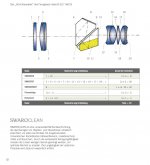While Schmidt-Pechan prisms are unique in requiring the two facing surfaces to be separated, to enable both the transmission and reflection functions, there is more to consider.
Firstly, there is a third combined transmission/ reflection surface on the S-P pair i.e. there are two such surfaces on the Schmidt prism.
And other roof prisms may have none, one or two combined function surfaces. So a consideration for optics designers:
• None: Abbe-Koenig; Hensoldt Penta, and; Ludewig (a combined prism and mirror)
• One: Sprenger-Leman (and a variation: Moller Theatis), and; Moller Tourix [a Hensoldt Penta variation] (and variations of the Moller: Zeiss Telita I and Telita II)
• Two: Uppendahl
• Three: Schmidt-Pechan
See the images in the first link in post #57 above.
- - - -
Particularly in relation to Schmidt-Pechan prisms . . .
In 1991, the article 'Progress in binocular design' was published by Konrad Seil, who was then working at Swarovski Optik *
Konrad demonstrated how a single layer of anti-reflective coating on the combined transmission/ reflection surfaces, was the best choice in terms of optimising the image (see pages 55 and 56).
Then in 2008, Swarovski published a diagram showing the coatings on the optics of the SLC 7x42 **
As can be seen, it shows 3 layers of coating on each of the combined function surfaces. So unsurprisingly there had been progress on the issue. And the diagram also shows at least 3 layers on each transmission surface - both on the lenses and prisms.
However, this does not mean that the same 3 layers are used on all of the surfaces (optical engineers have a wide range of coatings to draw from). One obvious example is that on many binoculars the objective and eyepiece surfaces clearly show different coloured reflections.
So it’s likely that the 3 layers on the combined function surfaces of the prisms are specifically designed to better address the reflection/ transmission problem, then was possible back in the early 1990’s (perhaps each coating has a narrow band width addressing a specific portion of the visible spectrum?).
- - - -
In addition, the table with the SLC diagram distinguishes between:
• the 3 layers of A-R coating applied to the internal surfaces, described as Swarotop, and
• the 4 layers applied to the two external surfaces, described collectively as Swarodur.
A page on the recently updated Swarovski website has the following:
'What is Swarotop and Swarodur?
. . . These two coatings are used on all lenses and prisms in Swarovski Optik long-range optical devices.
Swarodur is the sum of all external coatings.
Swarotop is the sum of all coatings on the internal lenses and prisms, optimized to ensure maximum light transmission and excellent color rendering.'
See at:
My Service
We know that Swarodur indicates a hard protective coating applied to external lens surfaces. However, it may be that the 3 lower layers that would normally just provide an A-R function, also need to be significantly modified to enable the top layer to fulfil its abrasion and impact resistance functions (e.g. while the top layer may hold up to a certain level of stress, conventional lower A-R layers might come away from the glass?)
- - - -
The text added to the bottom of the SLC diagram reads via Google Translate as:
'Swaroclean is a lens outer surface coating, which makes cleaning objective and eyepiece lenses much easier, especially when they come into contact with dried-on mineral residues (water stains), insect repellant and tree resin. Due to the improved cleanability, the lenses do not have to be cleaned as intensively in order to achieve optimal clarity. This significantly increases the longevity of the optical products.'
As Swaroclean was introduced in 2007, the diagram would predate its introduction (and Swaroclean would be a 5th and outermost layer on the two external surfaces).
While on its introduction Swaroclean was applied to most products, this did not include the Habicht Porro prism binoculars. And since then it has not been used on some new introductions such as the various CL lines.
Most significantly, correspondence that retired2021 has recently received from Swarovski, indicates that the use of Swaroclean was discontinued in 2020:
So hopefully some more points of interest.
John
* The 13 page article can be downloaded at:
https://wp.optics.arizona.edu/optomech/wp-content/uploads/sites/53/2016/10/Seil-1991.pdf
** The diagram is from Zielsicher Leitfaden Hochwertiger Jagdoptik (‘Reliable guide to high quality hunting optics’). The 28 page booklet can be found at:
ZIELSICHER LEITFADEN HOCHWERTIGER JAGDOPTIK - PDF Kostenfreier Download However there does not seem to have been an English counterpart.








